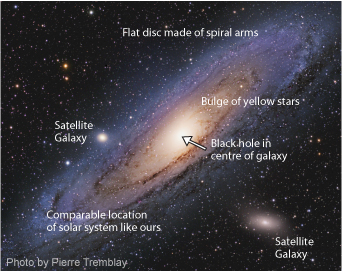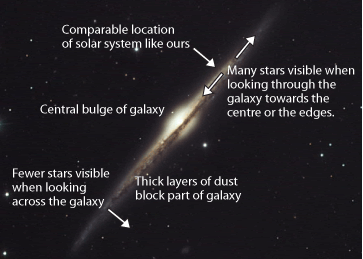
 The Milky Way is our galaxy. You can see part of it on really dark nights, as shown on your Star Finder.
The Milky Way is our galaxy. You can see part of it on really dark nights, as shown on your Star Finder.
Astronomers think the Universe started with a big explosion called the "Big Bang." Sometime after that stars, then globular clusters, then galaxies formed.
This picture shows M31, our nearest large galaxy. The Milky Way has a similar shape.
Outside the galaxy are two companion galaxies in orbit. The Milky Way has similar companions; the Large and Small Magellanic Clouds, which can only be seen from the southern hemisphere.
Spiral galaxies like M31 and the Milky Way are mostly flat, but there is a bulge near the centre. This bulge consists mostly of old yellow stars.
At the very centre of many galaxies is a massive black hole. Our galaxy's black hole has the mass of 4 million suns packed into a sphere smaller than the orbit of Mercury. The mass is found from the orbits of stars around it, shown on this video. Just as with planets in our Solar System, stars closer to the centre orbit faster.
Outside the bulge, the galaxy is mostly flat. The disc is made of younger stars, the brightest of which are blue. They form into spiral arms. Our Solar System is about halfway from the centre of the Milky Way to the outer edge.
 When we look along the flat disc of the Milky Way, we can see many stars. When we look perpendicular to the disc, we see fewer stars.The star Fomalhaut can be seen to the South on October evenings. It's almost directly below the Milky Way. Ancient astronomers, who had no idea of our galaxy’s shape, called it the "Lonely Star of Autumn."
When we look along the flat disc of the Milky Way, we can see many stars. When we look perpendicular to the disc, we see fewer stars.The star Fomalhaut can be seen to the South on October evenings. It's almost directly below the Milky Way. Ancient astronomers, who had no idea of our galaxy’s shape, called it the "Lonely Star of Autumn."
This image by Robert Gendler, shows NGC 4565, a similar galaxy to ours but viewed from the edge.

This video shows stars moving around the black hole at the centre of the Milky Way.
A picture of a planet in orbit around Fomalhaut has been obtained from Hubble Telescope imaging.
A fun page for kids with some interesting facts about the Milky Way, including a picture of what the spiral arms of our galaxy would look like if we could see them.
